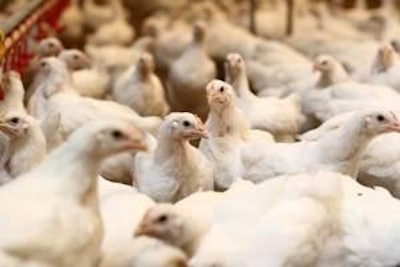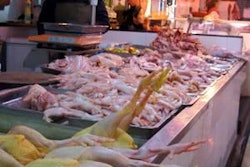
In 1996, the USDA FSIS published what came to be known as the "Mega-Reg," instituting salmonella performance standards for the first time. Twelve years later, all but two of the broiler processing facilities in the U.S. are meeting the standards through much hard work and effort throughout the farm to table continuum.
In June 2006, a new salmonella performance rule, which was even more stringent than the first, came into effect. Plants are now categorized as being in Category 1, 2, or 3. Category 1 plants are below 50% of the performance standard and are only sampled once every two years. Category 2 plants are at 50 to 99% of the performance standards and are sampled more than once every two years and Category 3 plants, those above the performance standard, are sampled several times a year. In addition, plants that have salmonella isolates of human health concern also receive greater regulatory scrutiny.
New focus on SE
Currently FSIS has indicated that it is concerned with the increased prevalence of Salmonella enteriditis (SE) in salmonella-positive carcass rinses over the last two years. What FSIS has not taken into consideration, however, is that its new sampling scheme biases toward those plants in Category 2 and 3, and is not a representative sample of serotype prevalence in U.S. poultry. This error of assumption has not stopped the agency from plunging ahead. Plans are in the works to penalize processing establishments based on the presence of SE or other serotypes of human health concern such as S. typhimurium (ST), S. heidelberg, S. hadar, and others.
Pullet vaccination is the first step
What FSIS does not seem to realize is that while processing plants can control the level of salmonella exiting their operations, there is nothing the plant does or can do to influence the specific serotypes present in an operation. In fact, the only intervention existing that can control a specific serotype is the use of killed salmonella vaccines targeting that serotype in a company's breeder vaccination program. The only way for broiler operations to reduce the specific serotypes at processing that concern FSIS is by developing a vaccination program specifically against those serotypes. This almost always requires the use of an autogenous bacterin. Fortunately, the serotype profile in a given operation is more a representation of the breed mix used and does not shift much over time, so the serotypes included in the bacterin do not need to be changed frequently.
The use of live and killed vaccines against salmonella have been most widely used in the commercial egg industry. Their use for salmonella control in meat birds in the U.S. has been confined mostly to those operations that needed assistance in meeting the salmonella standards in processing. Salmonella control in live production focuses on keeping salmonella-negative birds negative as infected birds can rarely be converted to negative status. In other words, for live production interventions such as water acidification, litter acidification, feed treatments and competitive exclusion to be effective, the majority of broilers must be negative at hatch. Primary breeders deliver day-old pullets and cockerels with salmonella infections below the level of detection and the integrator's job is to keep them that way. The use of a complete live and killed vaccination program in the pullets keeps the level of horizontal transmission among the breeders and vertical transmission to the progeny at a minimum. This allows the other interventions to be successful in reducing horizontal transmission in the broiler house prior to processing.
Multi-step process
Salmonella vaccination, like most other, uses a live "primer" vaccine (usually an ST) followed by the administration of a killed bacterin. The mode of action of the live vaccine is two-fold: the development of localized mucosal immunity to salmonella and a competitive exclusion of wild-type salmonella by the vaccine strain. The administration of the live vaccine prior to the killed vaccine has been shown to dramatically increase the mucosal antibody response to the killed bacterin in addition to reducing organ colonization and fecal shedding. In addition, maternal antibodies are passed to the progeny that may help decrease early colonization in broilers.
Autogenous vaccines work best
The key to customizing the vaccine program for the specific operation is to use an autogenous killed vaccine rather than one that is off the shelf. Most processing plants do their own salmonella sampling program in addition to the regulatory samples collected by FSIS. Since most plants do not utilize standard bench-top microbiology procedures for their salmonella testing, it is important for carcass rinses to be retained so that those which are positive can be sent for salmonella culture and serotyping. These carcass rinse isolates are the ones that should be used for developing the autogenous vaccines as the only isolates of importance are those that make it to the plant. You may also want to fast day-old broiler chicks for two to three days before culturing for salmonella to compare those isolates present at hatch with those present at processing. If an SE or ST is isolated at hatch, but not at processing, these should also be included in your autogenous vaccine.
Most autogenous vaccines are limited to three or four serotypes that are included in equal measure in the custom vaccine. In the U.S., the most frequently isolated serotypes are S. kentucky, SE, ST, and S. heidelberg, so these are the ones most commonly included. Not all serotypes are equally antigenic and currently there is no easy way to determine which ones are less antigenic and, therefore, should be in higher proportions in the vaccine. In addition to customizing the serotypes included, the adjuvant used can also be customized to minimize the vaccine reactions in the hen.
In most complexes, the result of such a customized program is a dramatic decrease in the number of salmonella-positive broilers at hatch and a decrease in incidence at processing. In addition, those serotypes of human health concern included in the program are also reduced with isolation becoming increasingly difficult. In some complexes, the human health serotypes included in the vaccine were not able to be re-isolated in two years time when the autogenous serial had to be renewed. While this can create difficulty for manufacturing more vaccine, APHIS has been flexible in working with companies on their autogenous salmonella programs due to the food safety aspect. SE and S. heidelberg are a bit more difficult to control, so continued isolation is often possible but the levels are significantly reduced from the pre-vaccination load.
In summary, if FSIS continues to focus on the presence of specific serotypes at processing, the only targeted tool that integrators have at their disposal is a killed vaccination program in the breeders that targets those specific serotypes. No other intervention is serotype specific.
A complete program of vaccination coupled with other pre-harvest interventions is necessary to reduce both overall salmonella incidence and specific serotype prevalence.















